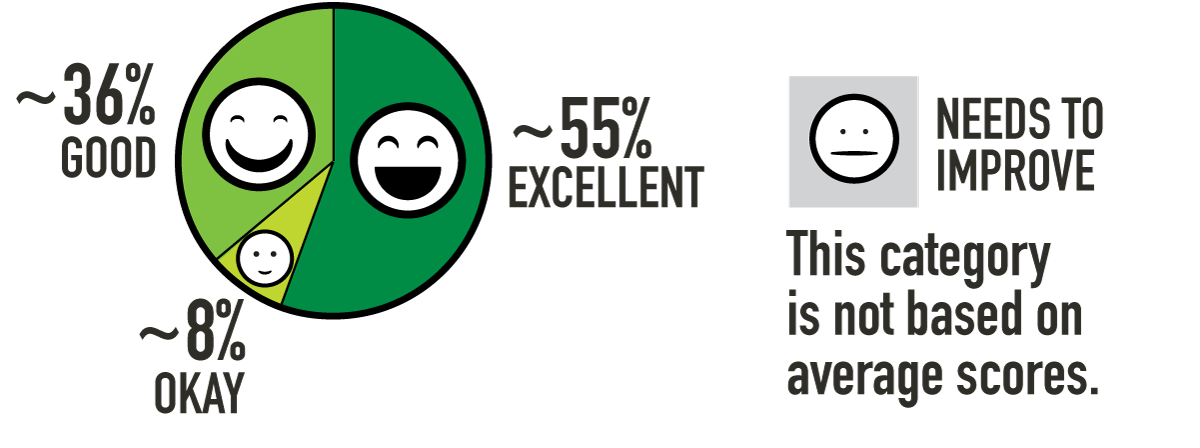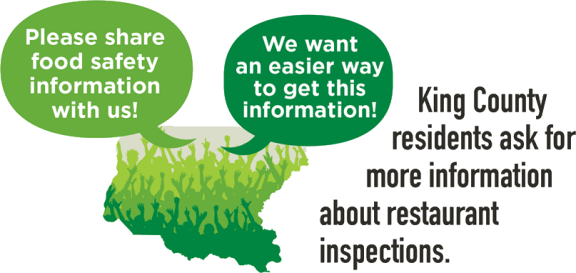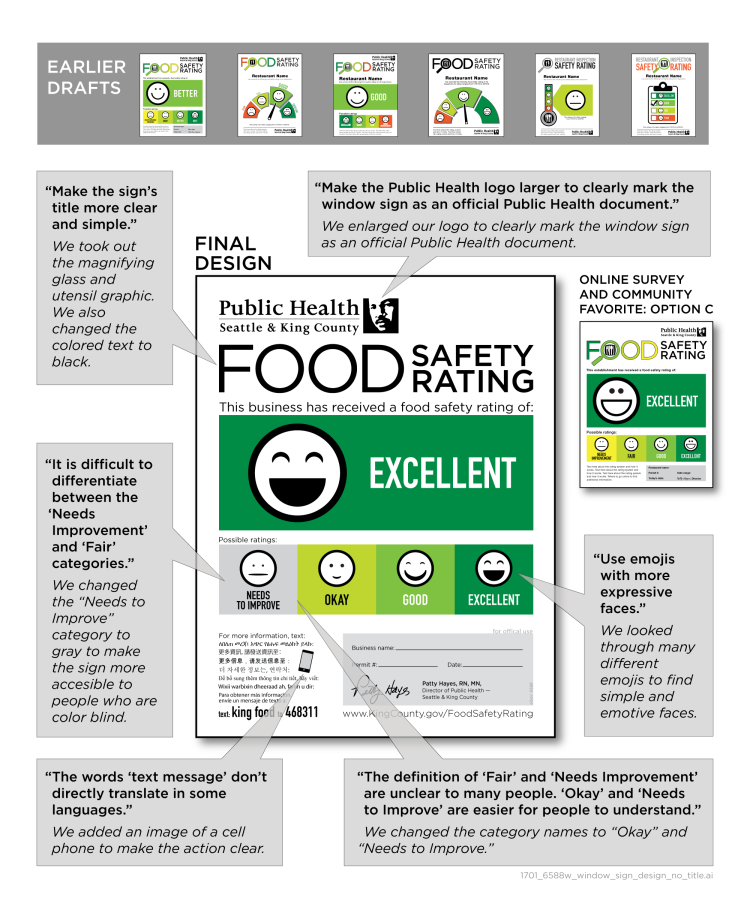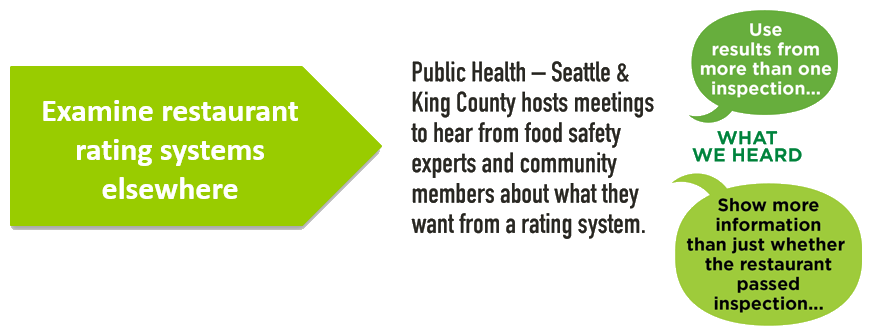Food safety rating system
Learn how we rate food safety in King County and communicate ratings with the public.
Select a topic
Search restaurant inspections
Find restaurant inspection histories for food establishments in King County.
Food safety rating categories
Food service establishments receive one of four food safety ratings to provide the public with more information about the level of food safety practices, helping them make informed decisions about eating out. If a food service establishment is open for business it meets minimum food safety standards to operate.
The four food safety ratings are:
- Excellent
Consistently followed high standards for safe food handling. - Good
Exceeded the minimum requirements for safe food handling. - Okay
Met the minimum requirements for safe food handling. - Needs to improve
Was either closed within the last 90 days or needed multiple return inspections to correct unsafe food handling.

The following grade breaks are applied to determine an establishment’s food safety rating, as follows:
| Food Service Establishment Risk Level | Rating | Min | Max | Timeframe |
|---|---|---|---|---|
3 |
Excellent | 0.00 | 3.75 | Average of last four routine inspections |
| Good | 3.76 | 16.25 | ||
| Okay | 16.26 | max | ||
2 |
Excellent | 0.00 | 0.00 | Average of last two routine inspections |
| Good | 0.01 | 5.00 | ||
| Okay | 5.01 | max | ||
1 |
Excellent | 0.00 | 0.00 | |
| Good | 0.01 | 5.00 | ||
| Okay | 5.01 | max |
What is behind a restaurant's rating?
A restaurant's rating category is determined by two main components:
- Trend of food safety practices over time. Good food safety needs to be practiced every day. The food safety rating window signs will reflect how well a restaurant has performed over time, not just on a single inspection. A restaurant's food safety rating for risk III* food establishments is determined by the average score of unsafe food handling practices of the last four routine inspections. However, for Risk I and II* food establishments, the food safety rating is determined by the average score of up to two routine inspections.
- Scale of performance. King County residents want to know more than if a restaurant passes or fails an inspection. The restaurant window signs will show how well the restaurant practices food safety beyond meeting the minimum standard.
*See section 4: “Permit types and risk categories” for definitions and examples of risk I, II, and III food establishments.
When we implemented this system in 2017, the approximate breakdown of the percentage of restaurants that fall into each category was: 55% 'Excellent,' 36% 'Good' and 8% 'Okay.' The 'Needs to improve' category means the restaurant was either closed by Public Health within the last 90 days or needed multiple return inspections to correct unsafe food handling practices. This category is not based on average scores.

Sign posting requirements
In the Food Safety Rating System, restaurants are required to post their window sign. Since every restaurant is different, Food Inspectors will work with restaurants to find the best place to post the window sign in accordance to the code of the King County Board of Health (218 KB).
According to the code of the King County Board of Health window signs must be clearly visible to passersby.
Each window sign must be posted:
- Within five feet of the main public entrance so the sign is clearly visible to people passing by or entering the establishment; or
- In a conspicuous location at the establishment as approved by the Food Inspector to ensure the sign is clearly visible to people passing by or entering the establishment.
If window signs are not correctly posted according to the rules above, a penalty fee can be charged. Penalty fees are a percentage of a business' annual permit fee. The penalty fee grows incrementally and with each offense.
| Offense (in 2-year period) | Penalty fee |
|---|---|
| 1st offense | 50% of permit fee* |
| 2nd offense | 100% of permit fee |
| 3rd and subsequent offenses | 200% of permit fee |
* Applying a fee that is % of permit cost is more equitable because it is relative scale to the business size.
The above code was passed by the Board of Health on January, 19, 2017. Watch a video of the recorded meeting.
Permit types and risk categories
Who's included in the Food Safety Rating System?
As of now, food businesses with what we call a General Food Service permit are included in the rating system. This includes restaurants large and small, coffee shops, bars and even the delis inside large grocery stores.
There are three different risk categories within the General Food Service permit.
- Risk 1 businesses are primarily grab and go and do not prepare food on-site.
- Risk 2 restaurants are moderate risk, they assemble food on-site but do not prepare food from scratch.
- Risk 3 restaurants prepare food from scratch and are more complex, which puts them in a higher risk category.
Each risk category is compared against businesses within their risk category, and not with businesses in other categories.
Developing the new food safety rating system
Public Health — Seattle & King County gathered recommendations, priorities and concerns from restaurant operators, food safety experts, diverse language speaking communities and people affected by foodborne illness. This feedback combined with research, informed the development of the new Food Safety Rating System.

Designing the restaurant window sign
Six window sign designs were reviewed by communities across King County to make sure they were easy to understand by people of many different cultures and by people who speak many different languages. We organized community meetings and visited over 100 restaurants to gather feedback on the window sign designs and to understand community priorities regarding the new rating system. An online survey, available in English and seven other languages, also gathered feedback on the restaurant window sign designs. The restaurant window signs include a number to text to learn more about what a restaurant's rating means. This information is available in Amharic, Cantonese, English, Korean, Mandarin, Spanish, Somali and Vietnamese.
We've received over 3,500 responses! Thank you for your feedback. We used your feedback to inform the designer of the final sign.

Equity and fairness is important to Public Health — Seattle & King County
The new Food Safety Rating System was designed to advance equity and fairness. Here are some ways we incorporated equity and fairness into our system.
- Our rating methods were designed to fairly measure a restaurant's food safety practices by focusing on trend over time, scale of performance, and applying the same standards throughout the county.
- We listened to the concerns of restaurant operators about food safety inspection consistency. To address this concern we provided extra training and started peer review inspections where staff conduct inspections side by side to learn from each other. This helps make inspectors more consistent with each other.
- The development of the Food Safety Rating System was a collaborative process which included extensive outreach to restaurants, communities, food safety experts and King County residents.
Our food safety rating system will be evaluated in collaboration with community partners. We are committed to making changes based on evaluation results in order to advance equity and fairness.

Related blog posts from the Public Health Insider
- With the new year comes a new way to rate food safety: a Q&A with Becky Elias and Damarys Espinoza
- Seattle Restaurant Alliance weighs in on our new food safety rating system
- Two heads are better than one: one step closer to restaurant grading
- Eagerly awaiting restaurant placarding? Here are the next best things
- Food inspection grades: A – B – C, easy as 1 – 2 – 3 … or is it?

 Translate
Translate